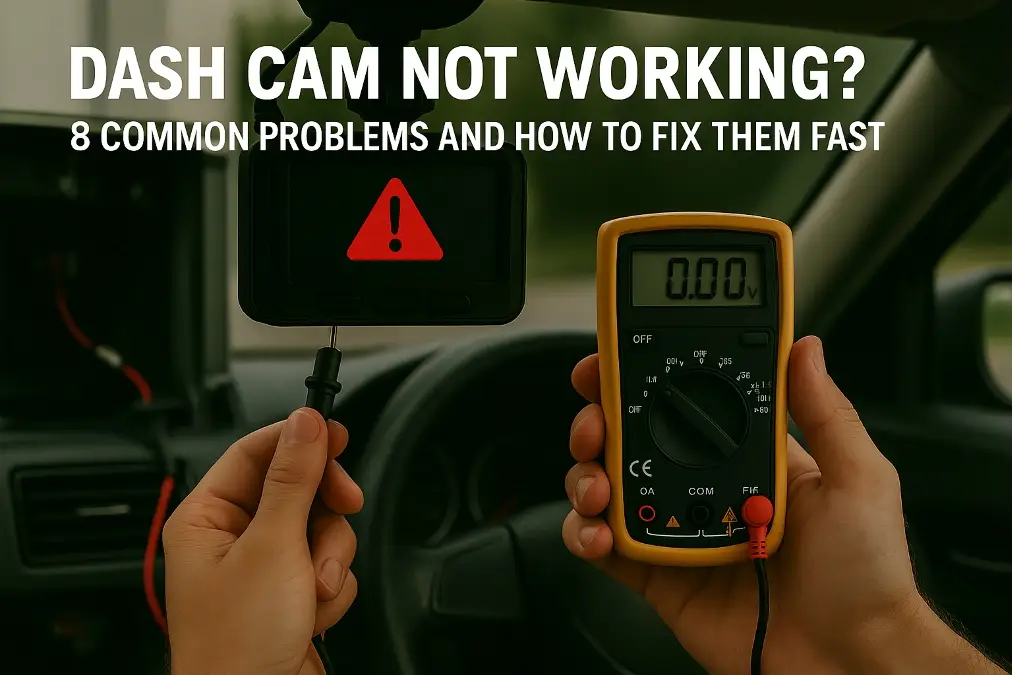Your dash cam is supposed to be your silent witness, but it's failing you. You're left unprotected on the road, wondering if the problem is simple or complex.
First, diagnose your power source and SD card. The vast majority of dash cam failures stem from a loose connection, a bad fuse, or a corrupted or incompatible memory card. Systematically checking these two areas will solve most issues.
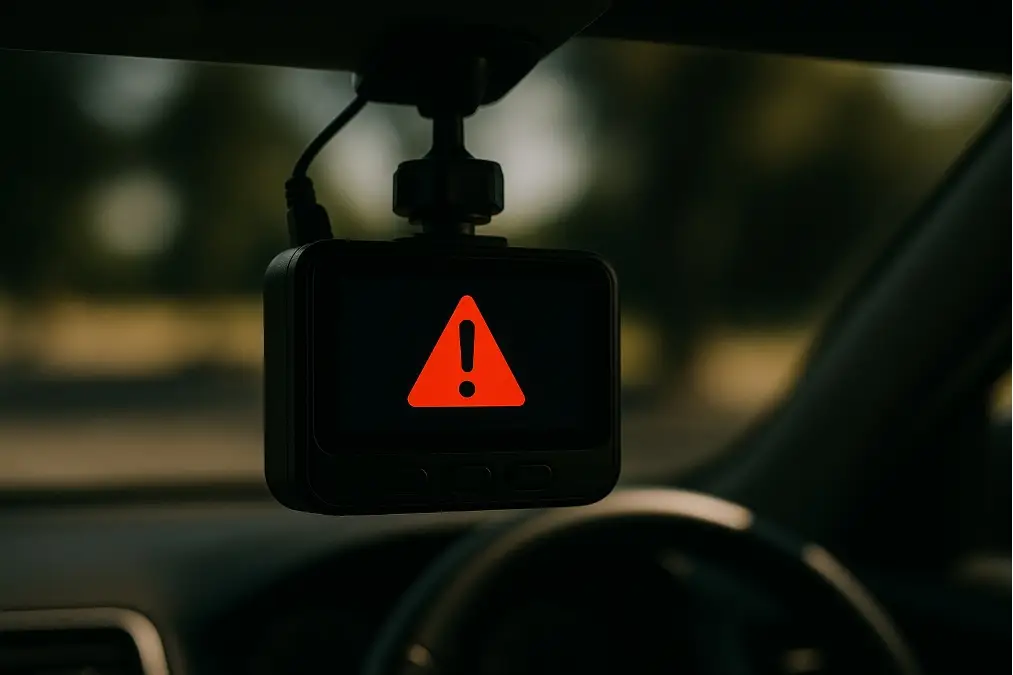
As the founder of VST Tech, I've seen it all when it comes to vehicle electronics. I understand the frustration of spending time on a meticulous installation, only to have the device fail. It's not just an inconvenience; it feels like a compromise on the safety you were trying to secure. But before you consider the unit faulty, let's walk through a professional diagnostic process. Often, the root cause is something you can identify and fix in minutes with the right approach. Let's get your system back to being the reliable guardian it was designed to be.
The Foundation: Why Won't My Dash Cam Even Turn On?
You've wired everything perfectly, routing cables neatly through the trim. Yet, the screen is black and the device is completely unresponsive. Is it a faulty unit or a simple oversight?
For hardwired kits, use a multimeter to confirm the B+ wire has constant 12V+ and the ACC wire has ~12V only when the engine is on. For cigarette lighter adapters, check the plug's internal fuse.
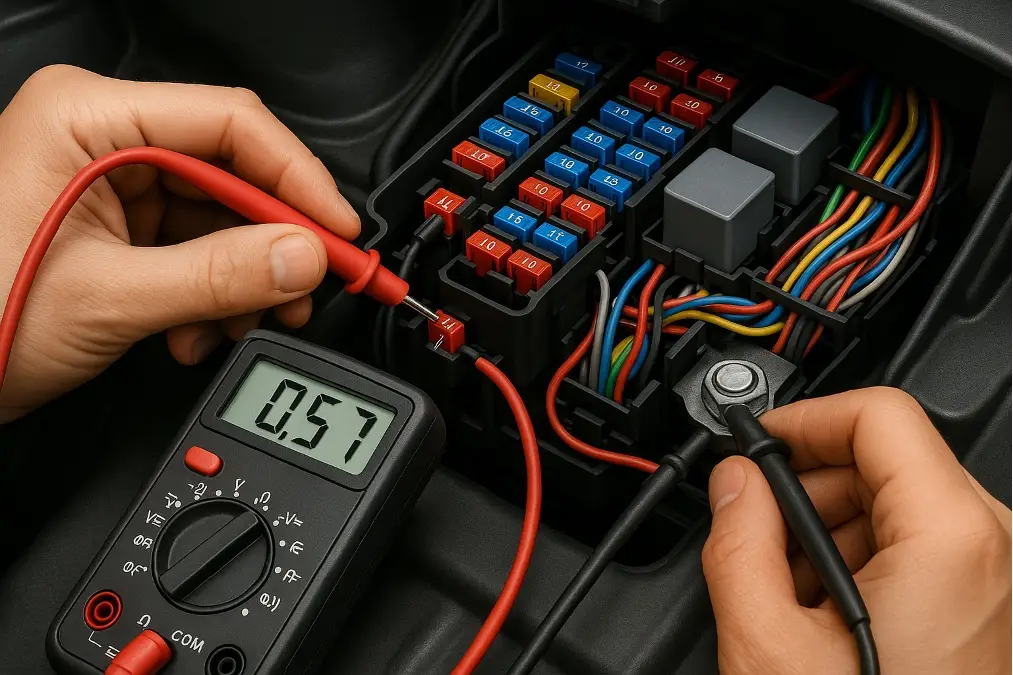
Power is the lifeblood of any electronic device, and an unstable supply is the number one cause of failure. As an electronics technician, you live by this rule, but it’s always where we must start. The problem can be the source (the fuse box), the pathway (the cable), or the connection point. Let's isolate the variable. With a hardwire kit, your multimeter is your best friend. A cheap kit might have poor voltage regulation, causing reboots, but a total lack of power is usually a connection issue.
A Pro's Power Diagnostic Flow
Follow these steps to find the break in the power chain:
- Grounding: First, confirm your ground (GND) wire is attached to a bare metal bolt or screw on the car's chassis. A painted surface will not provide a reliable ground.
- Multimeter Test: Set your multimeter to DC Voltage. Connect the black probe to your confirmed ground point.
- Test the Fuses: Use the red probe to test the specific fuse taps you've used. This is a more accurate test than just visually inspecting the fuse.
| Wire to Test | Engine State | Expected Multimeter Reading | Common Problem if Reading is Incorrect |
|---|---|---|---|
| B+ (Yellow) | OFF | ~12V - 12.6V | You've chosen a switched fuse (e.g., radio, wipers). |
| ACC (Red) | OFF | 0V | You've chosen a constant-power fuse. |
| ACC (Red) | ON (Ignition) | ~12V - 14.4V | Fuse is dead or you've chosen a non-powered slot. |
If these voltages are correct at the fuse tap, the issue lies within the hardwire kit's cable or its converter box.
The 'SD Card Error' Nightmare: Is Your Memory Card the Real Culprit?
The camera powers on, the screen looks fine, but it immediately flashes "SD Card Error" or "Please Insert SD Card." You worry that none of your drives have been recorded.
This error is almost always due to the card itself. You must use a high-quality "High Endurance" card designed for constant rewriting. Standard cards will fail quickly, causing these errors.
At VST Tech, we can't stress this enough: the SD card is the single most critical component for dash cam reliability. A dash cam is an extreme-use case for flash memory. Unlike a phone or digital camera that writes data intermittently, a dash cam writes and rewrites data for hours every single day. This constant activity, known as Program/Erase (P/E) cycles1, rapidly wears out the NAND flash cells on a standard memory card. Manufacturers of cheap cards use lower-grade TLC (Triple-Level Cell) NAND that is not built for this workload. High-endurance cards use higher-grade MLC (Multi-Level Cell) or specialized TLC NAND designed to withstand tens of thousands of P/E cycles.
Why Card Choice and Formatting are Non-Negotiable
Using the wrong card is like putting budget tires on a high-performance car—it will fail.
- Required Specs: Look for a U3 / V30 speed rating and the "High Endurance" label. Brands like SanDisk, Samsung, or Lexar offer specific product lines for this purpose.
- The Formatting Ritual: Formatting isn't just about deleting files. It's a maintenance routine that resets the card's file allocation table, which can become corrupted from sudden power-offs (like turning off your car). It also clears locked "event" files from G-sensor triggers that aren't overwritten by loop recording. Crucially, always format the card inside the dash cam itself, not on your PC. This ensures the file system is perfectly matched to the camera's firmware, preventing data corruption. Forgetting to do this monthly is the second leading cause of card errors.
Why Isn't My Parking Mode Working Correctly?
You bought the camera specifically for its 24/7 surveillance capability. But you review the footage and find it stopped recording as soon as you turned the car off, leaving your vehicle unprotected.
This is a hardwiring installation error. Either your B+ and ACC wires are swapped, or the B+ wire is connected to a switched fuse instead of a constant-power fuse.
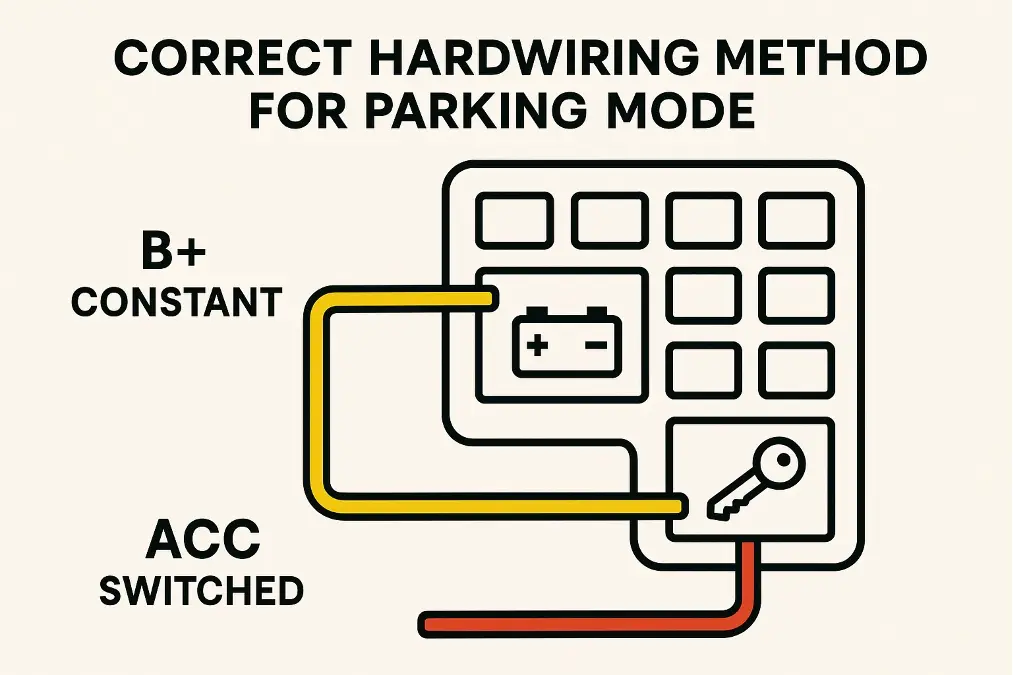
Parking mode is entirely dependent on a correct hardwire installation. The camera needs to know when the car is off so it can switch from normal recording to a low-power surveillance mode (like time-lapse or G-sensor-triggered recording). It determines this by monitoring the state of the two power wires. The B+ (Battery) wire provides the constant power needed to run in parking mode, while the ACC (Accessory) wire acts as a trigger. When the ACC wire loses its 12V signal (because you turned the car off), the camera's firmware knows to enter parking mode. If this signal is wired incorrectly, the camera will simply shut down completely with the car.
Diagnosing the Parking Mode Trigger
Let's verify the logic at the fuse box. The test is simple.
- Identify your wires: The B+ wire is almost always yellow, and the ACC wire is almost always red.
- Engine Off Test: With the car off, use a multimeter to probe the fuse your yellow wire is tapped into. It must read ~12V. Then probe the red wire's fuse. It must read 0V.
- Engine On Test: Start the car. The yellow wire's fuse should still read ~12V (or slightly higher, ~14V, as the alternator is running). The red wire's fuse should now read ~12-14V.
If your red wire has power when the engine is off, you've used a constant fuse for it. If your yellow wire has 0V when the engine is off, you've used a switched fuse for it. Swapping them to the correct fuse types will solve the problem. Also, check the camera's settings to ensure the voltage cutoff feature is set correctly (e.g., 12.0V or 11.8V) to prevent draining your car's battery.
Is Your Video Footage Blurry or Dark, Especially at Night?
Your daytime footage is crystal clear, but at night, license plates are an unreadable, glowing blur. Or perhaps shadowed areas in bright daylight are completely black, hiding important details.
This is a limitation of the camera's hardware. Superior night vision requires a high-quality image sensor with Wide Dynamic Range (WDR)2 and a lens with a large aperture (e.g., f/1.6).
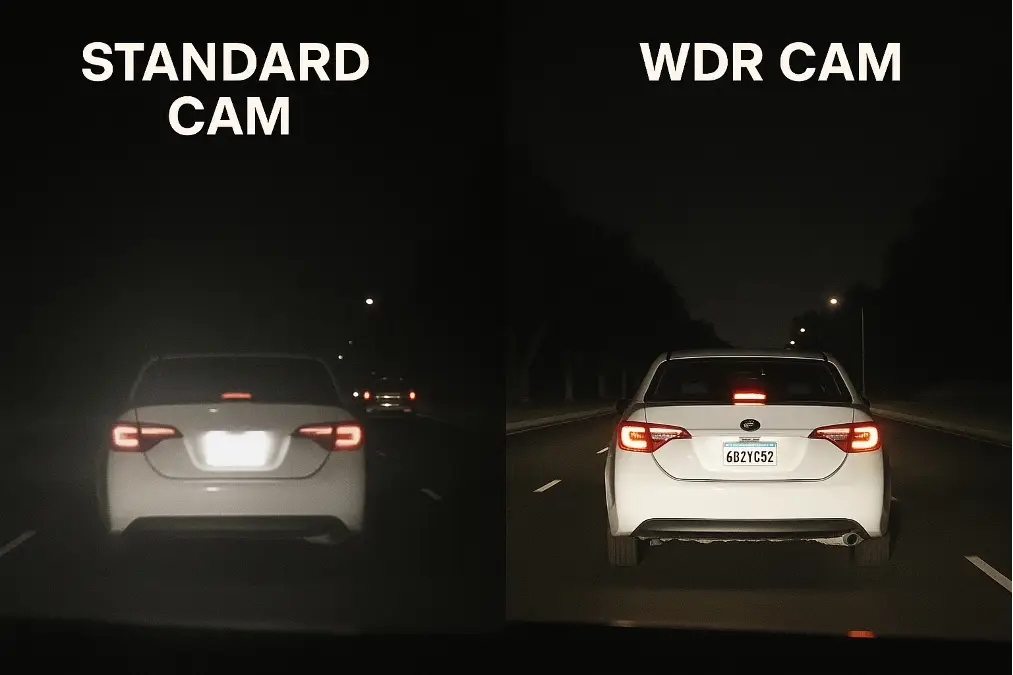
All video quality issues ultimately come down to one thing: light. How well the camera's sensor and lens can capture and process light in difficult conditions determines the usefulness of the footage. A cheap camera uses a small, basic sensor and lens that simply can't handle high-contrast scenes. This is why we at VST Tech invest heavily in premium Sony STARVIS sensors and large-aperture multi-element glass lenses. It's not a marketing gimmick; it's a fundamental engineering choice for safety. WDR (or HDR) technology is critical here. It works by capturing multiple exposures of the same frame—one short exposure to capture bright areas (like headlights and license plates) without blowing them out, and one long exposure to capture detail in the dark areas. The camera's processor then merges these into a single, balanced, and clear image.
Key Hardware Specs for Video Quality
When evaluating a dash cam, these are the specs that directly impact video clarity:
| Feature | What it Does | Why it Matters for Safety |
|---|---|---|
| WDR / HDR | Balances light and dark areas in the same frame. | Prevents license plates from being washed out by headlights at night. |
| Large Aperture (f/1.6, f/1.8) | The 'f-number' indicates how wide the lens can open. A lower number means more light enters. | Drastically improves low-light and night-time recording clarity. |
| Image Sensor (e.g., Sony STARVIS) | The electronic chip that converts light into the digital video signal. | High-quality sensors have better sensitivity, producing less noise (grain) in dark conditions. |
If your footage is poor, and you've already cleaned the lens and windshield, the issue is likely the core hardware of the camera itself.
Conclusión
Don't give up on your dash cam. By systematically troubleshooting power, the SD card, wiring, and settings, you can solve nearly any problem and restore your essential driving safety protection.

